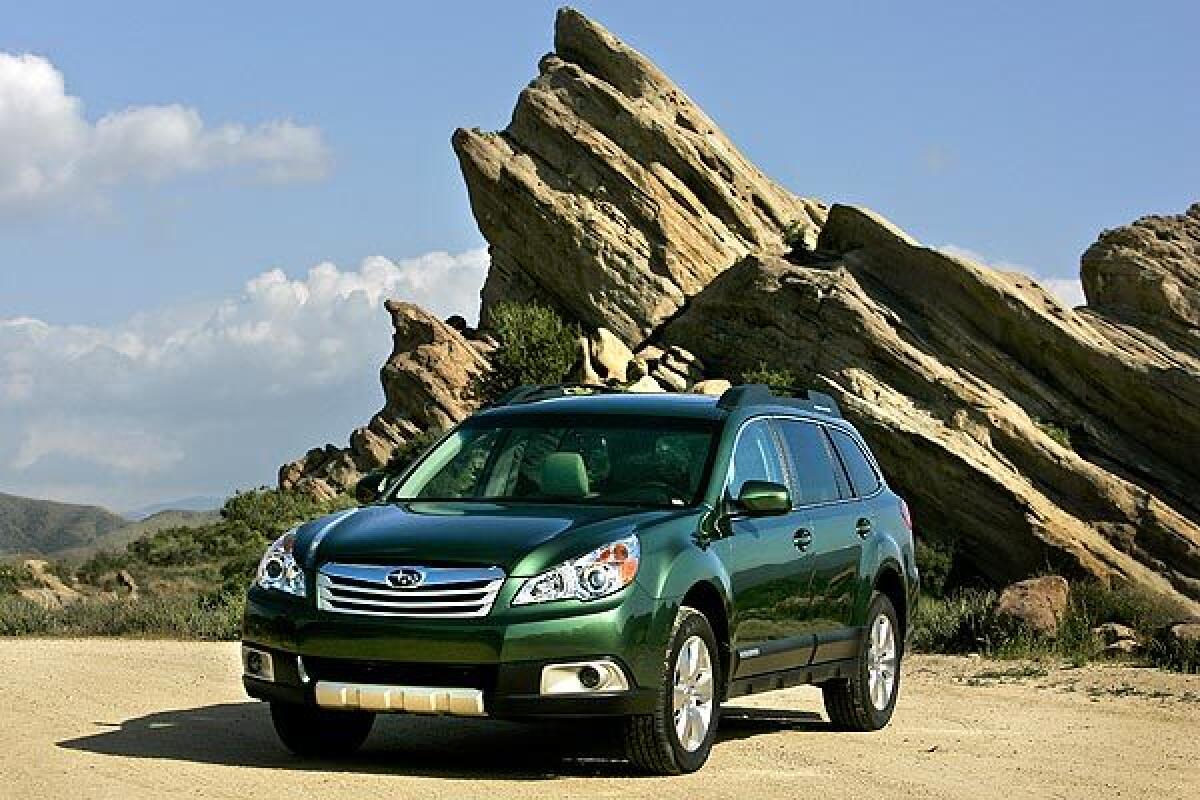Car review: Subaru Outback crosses a magical divide

- Share via
Magic. The word itself is thrilling. It promises surprises (good ones). Mystery. And if you’re lucky, a little humor.
Everyone knows the good stuff centers around optical illusions. Attractive blonds are cut in half, yet they maintain their game-show bright, five-out-of-five-dentists-recommend-your-teeth-look-like-this smile.
Pull your annoying nephew out of the crowd and lay him on a table. Good magic will levitate him a dozen feet above the stage with the aid of little more than some opportune puffs of smoke.
So don’t be surprised if the next time you see your local magician headed to the mustache-wax emporium, he’s driving Subaru’s 2010 Outback. Any good magician will appreciate the phantasmagoria the folks at Subaru pulled off when redesigning this model.
From the outside, the Outback looks as if your run-of-the-mill station wagon put on a Gore-Tex jacket and some hiking boots, and perhaps ate a ClifBar. It looks like a butch wagon and nothing more.
But climb inside and voila! Suddenly you’re in an SUV, with the same field of vision and command of the road.
Subaru pulled off this trick by increasing the wheelbase, width and height of the car, while cutting the length and weight. This isn’t obvious until you’re inside, lolling about. Any seat in the house is a roomy and comfortable one.
The cavernous trunk swallows cargo so there’s plenty of room for cages of rabbits or boxes of top hats. Controls are laid out in the logical manner you’d expect from a company that designs its all-wheel-drive cars for people who own more aluminum water bottles than they do neckties.
Previous versions of the Outback, and indeed the Legacy on which it was based, often paid for this AWD capability with sub-par gas mileage. I know this because I drive a decade-old, four-banger Legacy that gets only 24 mpg on the highway on its best day. More than one child of an Exxon board member enjoyed years of private school on my dime.
For 2010, Subaru got serious about making their Outbacks more economical. They paired their 2.5-liter, 170-horsepower, four-cylinder PZEV-certified engine with either a six-speed manual transmission or an optional Continuously Variable Transmission (CVT).
For those of us without an engineer in the family, a CVT is a more efficient type of transmission. Instead of the five or six fixed gear ratios you find on a normal automatic, a CVT has infinite gear ratios. This means the engine is always running at the optimum rpms relative to the car’s speed. Optimum rpms equal optimum mpgs.
Four-cylinder Outbacks with the CVT are now rated at 22 mpg in the city and 29 on the highway. Bonus granola goes to Subaru for mounting the CVT’s paddle shifters, which simulate an automatic’s distinct gears, on the steering wheel rather than the steering column.
The six-cylinder, 3.6-liter unit puts out a healthy 256 horsepower and 247 pound-feet of torque and comes only with a five-speed automatic. Gas mileage is rated at 18/25 mpg. Although the six-cylinder doesn’t necessarily hit the fuel economy honor roll like its four-cylinder sibling, it’s much quieter and more refined.
Take either version off-road and the Outback is in its element. With four-wheel independent suspension and 8.7 inches of ground clearance (more than some full-out SUVs), the Outback will be more than adequate, unless your last name is Sherpa.
I took my test model on a deeply rutted and long-neglected trail in the Malibu mountains and was often on three, and at one point two wheels. A pygmy goat on steroids couldn’t get around the trail faster.
The one drawback to all this ground clearance is that the car has a higher center of gravity, which results in some body roll in the tightest of corners.
This isn’t the only downside to the Outback, however. The increased mass makes the car more difficult to park. The side-view mirrors didn’t fold on the 2010 model I tested (my garage eats mirrors like your dryer eats socks). But Subaru wised up for the forthcoming 2011 models, which will include manual folding mirrors.
Finally, the Outback seems to suffer from a bout of aesthetic regression. The previous version was headed in a handsome, almost Audi-like direction. The front end of the new version looks like a surprised reptile.
Subarus have long been known for their value, and this Outback is no exception. The base model starts at around $23,000 for the 2.5i with a six-speed manual transmission, and tops out with the fully-loaded 3.6R Limited I tested, which runs about $34,700. And loaded it is: navigation system, backup camera, moon roof, leather, Harman Kardon stereo and climate control were all included.
Whether it was by good ol’ muggle know-how, or some genuine studying of Dark Arts for Dummies, Subaru has hit the sweet spot between the space and capability of an SUV and the pragmatism of a station wagon.
Cape and wand sold separately.
More to Read
Inside the business of entertainment
The Wide Shot brings you news, analysis and insights on everything from streaming wars to production — and what it all means for the future.
You may occasionally receive promotional content from the Los Angeles Times.











